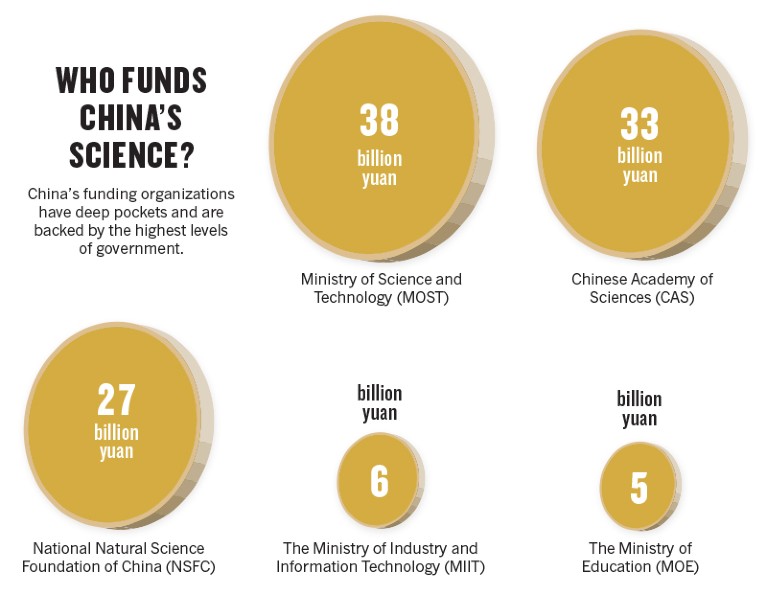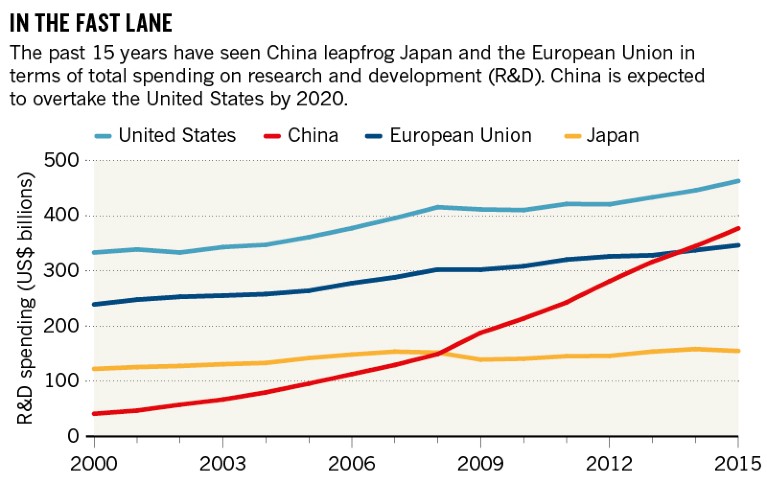
More than 7,000 high-fliers have relocated to China under the Thousand Talents Plan.Credit: miR156/Alamy
Theoretical chemist Jeffrey Reimers had been working in Sydney, Australia, for 28 years when he decided to relocate. In previous years he might have moved to the United States, but he decided that China’s deep pockets and ambitious research targets could better support his professional goals. “I wanted to do something that could not be done if I moved to the United States. I wanted the opportunity to expand my research, to ask some serious questions.”
Fast-forward four years and Reimers is now the director of the International Center for Quantum and Molecular Structure at Shanghai University, a multidisciplinary research hub with start-up funding of 20 million yuan (US$3 million). Since opening it in 2014, Reimers and his cofounder, returnee physicist Wei Ren, have hired more foreign scientists than native Chinese researchers to join their team.
The recruitment drive reflects the country’s desire to attract international expertise. “China has developed to a stage that it can and should attract excellent global science talents,” says Xiao-Fan Wang, a professor of pharmacology and cancer biology at Duke University in Durham, North Carolina, who frequently advises China’s leadership on science and technology policy. “Our leaders are aware that if China wants to compete for global leadership in the future, it is important to attract international talent as the United States did after the Second World War. They are aware that all important science papers are published in English and very few high achievers have made it without overseas experience.”
Go online today and you’ll find numerous job listings for research positions in China. Yet the country’s hunt for overseas talent only started in earnest relatively recently. In the early 1990s, China’s top governmental science bodies launched a succession of schemes designed to woo talent to its shores after decades of academic decline. China began recruiting skilled professionals from abroad as early as 1994. The earliest scheme, the Hundred Talents Program, attracted 2,145 scientists to China by the end of 2013. It was closely followed, in 1997, by the Changjiang Scholars Program to hire overseas Chinese academics, which brought 2,251 professors back by 2014. Both foreign and ethnically Chinese scientists were encouraged to apply, and the majority of successful candidates were junior faculty members.
China aims high
But the recruitment landscape has dramatically changed from welcoming nearly all foreign-trained PhD holders to primarily recruiting potential academic leaders or those with significant academic outputs. Hailiang Yu, a professor in the School of Mechanical and Electrical Engineering at Changsha-based Central South University, said that for the past three years his school has no longer been interested in recruiting foreign graduates — it only advertises widely for senior research staff.
In 2008, China re-focused its recruitment efforts on high-end academics and introduced the Thousand Talents Plan, which offered incentives such as high salaries to Chinese-born, Western-trained professors who were willing to return to China. Two years later the scheme was extended to foreigners, and an additional Youth Talents Plan was created to attract promising researchers up to the age of 40. By mid-2017, the Thousand Talents Plan had attracted more than 7,000 scientists to China, including 2,900 under the Youth Talents Plan and 381 foreigners.
China’s timing was prudent. Research funding in the West was badly hit by the effects of the global financial crisis in 2008, at the same time that China was pouring money into recruitment. The country promised overseas professors start-up packages of up to 20 million yuan, including annual salaries of up to 1 million yuan in addition to a relocation payment of 1 million yuan. Reimers was one of the programme’s recruits.
Figures released by the Chinese government suggest that these programmes have jointly attracted nearly 15,000 scientists to the country — predominantly, but not exclusively, Chinese returnees. Former President Hu Jintao, who led China from 2003 to 2013, stressed the importance of cultivating talent to bolster the country’s industrial development throughout his tenure. His commitment to building up China’s pool of skilled researchers has been continued by current leader President Xi Jinping, who in 2017 said that in the next five years, 50 more collaborative projects would be set up between Chinese and foreign scientists to encourage “talent exchange”. China will also invite 2,500 young foreign scientists on short-term research visits.
“Attracting senior talents is placed at the centre of China’s policy agenda and hence becomes a central task,” says Xiong Zhou, deputy director of human resources at Huazhong Agricultural University in Wuhan. Neuroscientist Lu Bai at Tsinghua University in Beijing adds: “Now, we can compete with many leading Western universities for smart young talents with comparable benefit packages.”
Chinese-born scientist Weiwei Deng, a professor of mechanics at the Shenzhen-based Southern University of Science and Technology (SUSTech), says he was offered an annual 9.5 million yuan in start-up funding for three years. Deng was a tenured associate professor at Virginia Tech in Blacksburg before he joined SUSTech through the Thousand Youth Talents Plan in early 2017. “In these three years, I can do what I want without spending time on thinking about grant proposals,” he says (see ‘Who funds China’s science?’).

Sources: www.gov.cn/www.cas.cn
Researchers tend to find China’s science spending much more lavish than what they’re used to in the West. Zilong Qiu, a senior neuroscientist at the Shanghai-based Institute of Neuroscience of the Chinese Academy of Sciences, who returned to China from his postdoc position at the University of California, San Diego in 2009, says that many of his former colleagues can’t get as much done as they’d like owing to a lack of money.
But scientists looking for funding in China must align their research with national priorities, he says. “China is still a developing country. To gain funding, scientists must link their research plans to the government’s national demands, such as controlling diseases, rather than purely their own academic interests.”
The realities of job seeking
A common complaint among Chinese researchers is the blunt way that supervisors evaluate their performance. Institutions judge scientists on their publication record, often generously rewarding those whose work appears in high-impact journals. This pressure to publish has been associated with the spread of fraud among Chinese papers. For job seekers, the same evaluation method applies.
“The number of papers is the most important criteria for Chinese universities to recruit Thousand Youth Talents candidates, but to many emerging research areas like mine, it is hard to publish a paper in a high-impact journal,” says Guojun Shi, a cell biologist at the University of Michigan in Ann Arbor. Yet Lu is optimistic that the recruitment landscape is becoming more sophisticated. Leading universities, he says, are now keen to hire individuals who can be integrated into their research environment (see ‘Where to look’).
Another concern for job seekers is the part that nepotism plays in Chinese universities. Zhou notes that recruitment decisions are often reliant on personal connections. Scientists who have studied and worked abroad may struggle if they do not have the necessary patronage to secure funding and promotion. He recommends that Chinese institutions help newly recruited overseas scientists by arranging for them to work with senior scientists and in established labs.
There are no official guidelines for universities to follow when assimilating newcomers into the workplace, beyond the contractual obligations of the scheme. Reimers’ lab, for example, hired an English-speaking administrator to help foreign staff. But this kind of support is not guaranteed.
Future for foreigners?
Although China is committed to recruiting foreign talent (see ‘In the fast lane’), the numbers of overseas scientists based in China remain small compared to the researcher population of 1.5 million.

Source: OECD
According to Zhou, China’s recruitment schemes struggle inside a culture that is not used to hiring foreigners. In 2015, just 240,000 foreigners were issued with work permits in China. By comparison, more than 530,000 temporary work permits were issued in the United States in 2016.
Language and cultural barriers, recruitment habits and huge supplies of Chinese nationals trained overseas are all factors explaining the few foreign scientists working in China, says Zhou. “It is only in recent years that Chinese universities began to advertise job openings in English in major international journals and academic websites,” he says.
Although China offers high salaries to scientists recruited through its talent schemes, its average faculty salary is almost half the US equivalent. Ren, the codirector of Reimers’ lab, says he regularly argues with his university’s administration for higher salaries for foreign faculty members. The Chinese government is aware that low salaries do not encourage and retain talent. In November 2016, China’s State Council issued guidelines for universities to increase the income of scientists through pay rises, greater rewards for research sold to companies and the use of grant funds to supplement salary.
But there are still national policies to be overcome when it comes to recruiting foreign scientists. “Many of our policies and practices need to be overhauled if we want to massively attract foreign science and technology talents,” says Huiyao Wang, director of the Beijing-based Center for China and Globalization, a think tank that advises the central government on talent policies. He notes that China issued 1,576 green cards, or permanent residencies, to foreigners in 2016, a 163% increase on 2015. By comparison, the United States issued around 1 million.
Yet Wang is optimistic. Last September, China’s cabinet issued a notice saying it will be easier for students in China and senior foreign professionals to gain work and residency permits after laws are reformed. Internal barriers that make it difficult for foreigners to directly apply for grant funding in the Chinese system, including the requirement for Mandarin to be used in proposals, are also gradually being loosened, says Wang.



 China’s plan to recruit talented researchers
China’s plan to recruit talented researchers
 Why China needs your scientific expertise
Why China needs your scientific expertise
 The ups and downs of moving to China
The ups and downs of moving to China





